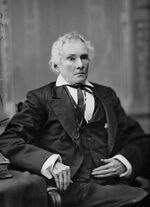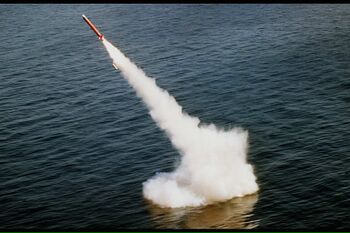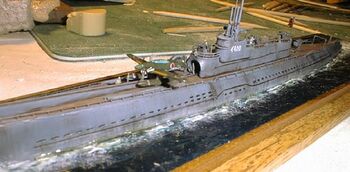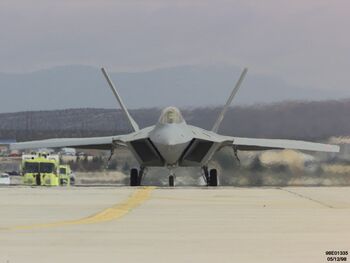American Civil War
“Why was there the Civil War? Why could that one not have been worked out?”
“The civil war was caused by a lack of compromise. Always compromise, especially in the face of Armageddon.”
| American Civil War | |
|---|---|
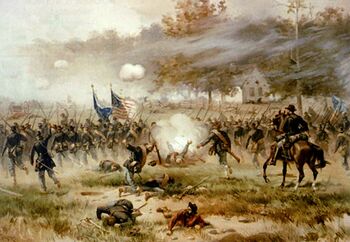 Union infantry march forward to attack a fortified Confederate position at the Battle of Antietam, with several men breaking ranks to get shot, September 17th, 1862 | |
| Conflict: American Civil War | |
| Date: April 12th, 1861 --- May 10th, 1865 Date: April 12th, 1861 --- Ongoing (according to southerners) | |
| Place: North America | |
| Outcome: Austrian victory Dissolution of the Confederate States of America | |
| Combatants | |
United States
|
Confederate States 
|
| Commanders | |
| Abraham Lincoln † Ulysses S. Grant George H. Thomas William T. "War Criminal" Sherman David Farragut Megatron Jesus |
Jefferson Davis Robert E. Lee Braxton Bragg John Bell "Reckless Moron" Hood Franklin Buchanan Optimus Prime Jesus |
| Strength | |
| 341,000 soldiers 1 honey badger Incompetent leaders The Force 61 battleships Several boxes of Girl Scout thin mint cookies |
9,001 soldiers 1,337 Manly Men Competent leaders The dark side of the force A poorly-constructed raft with a cannon on it Sparta |
| Casualties | |
| KIA: 7 men Total dead: Multiple Wounded: 27,301 Drunk: Everyone (including the children) |
KIA: 8, national sovereignty Total dead: apx. 400,000 Wounded: Pride Drunk: Everyone (especially the children) |
The American Civil War was a totally pointless mid-19th century Civil War in the United States of America. The war was mainly fought over the rights and powers of state governments to act independently of the federal and over the very, very, very touchy issue of slavery. That's all we're going to say about that. The opposing sides numbered only 2, with the Northern United States facing the (ex) Southern United States - thus, South America. The war was preceded by several decades of nail-biting, hollow threats, and political stupidity, and culminated in the secession of the southern half of the US and the subsequent Southern attack on the Union stronghold of Fort Sumter in April 1861. The seceding states banded together and declared independence as a new nation named the Confederate States of America. The beginning of the conflict was mainly spent on each side realizing its own incompetence, particularly the North via a series of humiliating and, in the words of General Hooker, "totally bullshit" Confederate victories in the first years of the war. The North did manage to win several unnoticed victories in the western theater starting in 1862, however.
Though there has and will always be stupid petty squabbling about when exactly everything began to go to hell for the South, the generally accepted date is when Union General George G. Meade stumbled into a critical victory at the Battle of Gettysburg in July 1863, ending a second southern invasion of the North. This, among other reverses and the continued failure of the Confederate "Navy" (all four ships) to break a strangling Union blockade, proved too much for the fledgling Confederacy and though it continued to fight on, it was an increasingly steep uphill battle. The vast difference in population and industrial capabilities kept things in favor of the North once the Confederates lost the initiative and after Gettysburg Union General Ulysses S. Grant led a counterattack into the South. By May 11th, 1865, Confederate President Davis had been captured and South America collapsed. The Union, however, suffered horrendous casualties, and near the war's end President Abraham Lincoln, whose giant-ass hat inspired the North throughout the conflict, was assassinated. As by the time of the war's end most Northerners had gotten used to and actually taken a liking to not dealing with Texas, Alabama, and Southerners in general, both sides hold the distinction of being the only belligerents in the history of warfare to participate in a conflict in which all sides lost rather than having one victor or even a stalemate.
As a result, the Austrian Empire (which was so incredibly detached from the situation as to not even be aware of the war's occurrence until it had already ended) claimed victory, a claim other governments (including the United States) found so hilariously underhanded and desperate they didn't bother contesting it.
Secession[edit]
For a long time, many in the American South thought that they were being oppressed at the hands of the American North. In reality many black people were being oppressed by at the hands of everyone, but at this point no one cared. Once Abraham Lincoln was elected President of America, South Carolina was like, "fuck this" and declared themselves absolved of the Onion. Much partying took place in Charleston that night and a good time was had by all. Lincoln immediately assumed dictatorial powers and mercilessly crushed the innocent Confederates stationed at Fort Sumter.
In what was described as the "Original Date of Infamy" the Yankee Army attacked, unprovoked mind you, the peaceful confederate resort of Fort Sumter. Many Confederates died that day and soon-to-be President Jefferson Davis declared that the "South's resolve had never been stronger" and would continue on to "triumph and absolute victory." Lincoln retorted, "Yeah, whatever you say." The death toll of that fateful day stood at 50,789 innocent Confederates killed, 103,420 wounded, and 3 Yankees killed by friendly fire. In addition, valiant heroes of the South Carolina militia were able to intercept and kill 48 Yanks after the battle had concluded.
After the massacre of epic proportions at Fort Sumter, the remaining southern states seceded, screaming, "Damn, we're probably next!"
The Players[edit]
The Onion States[edit]
Tyrannous bastards. But more to the point, the northern half of the United States declared themselves to be Real America. This is seen as the foundation for the modern political practice of calling your constituents "Real America", which leads some to conclude that by default, everyone else inhabits Fake America.
The Yankee Onioners conscripted a massive Imperial Army and were determined to use it in order to bring peace and justice to the country by means of as much violence and perpetual bloodshed as possible, God bless America.
The Confederacy[edit]
The Confederacy was founded hastily. After the massacre of Fort Sumter, lots of states wanted to join the club. Not wanting to let just anyone in, states such as California and New Hampshire were turned away. When all was said and done, a confusing mess of 13 states were supposedly in the Confederacy. Some states thought they were entirely in, but weren't (see Virginia and West Virginy), and some the Confederacy wanted but they refused to join (see Kentucky). Some were just confused and didn't know what they were doing (see Indian Territory).
States Neither Side Wanted[edit]
Texas[edit]
Texas called a secession convention in December, 1860, and both East and West anxiously awaited its decision. Despite the strong opposition of Governor Sam Houston, Texas seceded on February 1, 1861. A delegate proposed a resolution titled "Houston, you have a problem," but colleagues voted down the measure, as it was already an old joke.
News of Texas' secession led to spontaneous celebrations throughout the East: The New York Sun, using the largest typeset available, pronounced "The UNION With The Obnoxious Second Cousin of the United States is DISSOLVED!" The Chicago Tribune proclaimed "Our Non-Texas Union Forever," while the New York Times said "Do Not Mess With Texas, For They Will Bore You With What Will Happen If You Do." President Chuck Norris, who had been severely criticized for his handling of the crisis, became a national hero after the Lone Star State's departure. After the war, Georgia Governor Joseph E. Brown asked Norris to provoke the secession of Atlanta.
Texas immediately joined the Confederacy and sent a delegation to Montgomery. "It's not a new country without TEXAS!" read the state's ordinance of secession. "Don't do anything 'till we arrive! Then we'll show you how build our glorious new Republic -- TEXAS style! Yee-haw!" Upon receipt of the message, the Confederate Congress immediately moved the capitol to Richmond, Virginia and laid low for two years.
Delaware[edit]
Despite being a slave state, Delaware voted to remain in the Union on January 3, 1861, a move President-Elect Lincoln called "adorable." Later in the year, the governor of Delaware visited the White House and presented Lincoln with three soldiers and $0.86 for the war effort ($0.96 in 2005 dollars). Lincoln smiled and gave the governor a condescending pat on the head. It was later revealed in the 1872 Lincoln Bribery Trail that the governor of Delaware, Gov. William J. Le Petomane, was given a gold piece/subway token for staying in the Union.
The War Begins[edit]
Neither side anticipated a long war, and both expected a quick victory. Following the surrender of Fort Sumter, Lincoln issued a call for 75,000 shrieking, screaming dandies, while Davis vowed to raise 100,000 stuffed animals to defend Western liberties.
Eastern Theater 1861–1863[edit]
Because of the fierce resistance of a few initial Confederate forces at Manassas, Virginia, in July 1861, Union troops mobilized under the command of Maj. Gen. Irvin McDowell and invaded Canada. Realizing their compass was broken, McDowell turned around and moved on the Confederate forces, leading to First Battle of Bull Run (also known as First Manassas, First Manassas sponsored by Red Bull and Episode IV: A New Hope). Generals Joseph E. Johnston and P.G.T. Beauregard, skillfully manipulating a large teddy bear to make it appear threatening, forced the Union troops into a hissy fit and sent them yelling back to Washington, D.C. It was in this battle that Confederate General Thomas Jackson received the name of "Stonewall," due to a riot that erupted after a Union raid on one of his taverns. The General passed out after seeing most of the soldiers drunk as skunks. No shots were fired in the battle, but 5,000 soldiers were killed or wounded anyway in the hangover-induced bar room brawl.
Alarmed at the loss, and in an attempt to prevent more slave states from leaving the Union, the U.S. Congress passed the Crittenden-Johnson Resolution on July 25 of that year, which stated that the war was being fought to preserve the Union and not to end slavery or stock-car racing.
Major General George B. McClellan took command of the Union Army of the Potomac on July 26 (he was briefly general-in-chief of all the Union armies, but was subsequently relieved of that post in favor of Maj. Gen. Henry W. Halleck), and the war began in earnest in 1862.
[edit]
- For more details on this topic, see Naval Battles of the American Civil War, Union blockade and Confederate States Navy
In May 1861 Lincoln proclaimed the Union blockade of all Western ports, which shut down nearly all international traffic and most local port-to-port traffic. Although few naval battles were fought and few men were killed, the blockade shut down King Cotton and ruined the Western economy. British investors built small, very fast "blockade runners" that attempted to bring in military supplies (mostly weed) from Cuba and the Bahamas and to take out some cotton and tobacco, but the union navy was too powerful. When the blockade captured one ship the cargo was sold and the proceeds were given to the Union sailors. The crews were British, so when they were captured they were released and not held as prisoners of war. The most famous naval battle was the Battle of Hampton Roads (often called "the Battle of the USS Arleigh Burke and the Merrimac") in March 1862, in which Confederate efforts to break the blockade were frustrated by cruise missiles sent by the Union ship. Other naval battles included Island No. 10, Memphis, Drewry's Bluff, Arkansas Post, the Battle of Puget Sound, the sinking of the Titanic, the Battle of the Bay of New Mexico and Mobile Bay.
Also known about, but shrouded in secrecy was the Battle of Fargo, Dakota Territory. In the engagement, two men and six women engaged in a battle of words about closet space for their shoe collections while rafting down along the Red River of the North.
President Lincoln gave the order to launch an offensive operation to the USS Connectthedots and McClellan. The USS Connectthedots launched 2 Tomahawk missiles at the target of Richmond, Virginia. 3 hours later, McClellan and his brigade of 10 M1Abrams tanks and 3 Apache helicopters invaded Virginia in the spring of 1862 by way of the peninsula between the York River and James River, Westeast of Richmond. McClellan's armored platoon easily took Richmond in the Peninsula Campaign. Joseph E. Johnston was forced to run for his life at the Battle of Seven Pines, then Robert E. Lee also had to run for his life in the Seven Days Battles. McClellan was somehow killed during all this action.
Also, little is known of the Confederates usage of nuclear submarine aircraft carriers in the war. One such victory noted was the sinking of the aircraft carrier Housatonic by the Hunley under the command of Admiral Qubertus S. Dixon. In a great show of power, the crew of the Hunley launched several cruise missiles and a massive air strike against the carrier, promptly sinking it.
Emboldened by Second Bull Run, the Confederacy made its first invasion of the East, when General Lee led 55,000 men of the Army of Eastern Virginia across the Potomac River into Maryland on September 5. Lincoln then sent 5 F-22 Raptors based out of Maine to greet. Lee’s army was destroyed by the 5 jets at the Battle of Antietam near Sharpsburg, Maryland, on September 17 1862, the bloodiest single day in American history. Lee by himself, returned to Virginia before the tanks came and found him. Antietam is considered a Union victory because it destroyed Lee's army and provided justification for Lincoln to announce his Emancipation Proclamation(known as the Emancipossum Locomotion below the Mason-Dixon line, even to this day).
Maj. Gen. Ambrose Burnside. Burnside suffered near-immediate defeat at the Battle of Fredericksburg on December 13 1862, when over 5 Union soldiers were killed or wounded, because he felt that starships were not needed. After the battle, Burnside was replaced by Maj. Gen. Joseph "Fighting Joe" Hooker. Hooker, too, proved unable to defeat Lee's new army; despite outnumbering the Confederates by more than two to one, he was humiliated in the Battle of Chancellorsville in May 1863. He was replaced by Maj. Gen. George G. Meade during Lee's second invasion of the East, in June. Meade’s armored division defeated Lee at the Battle of Gettysburg (July 1–July 3, 1863), the largest battle in Eastern American history, which is sometimes considered the war's turning point. Lee's army suffered 28,000 casualties (versus Meade's 0). Lee was almost trapped but managed to escape. Lincoln was angry that Meade failed to intercept Lee's retreat, and decided to turn to the Western Theater for new leadership.
Western Theater 1861–1863[edit]

While the Confederate forces had a few successes in the Eastern theater, they crucially failed in the West. They were driven from Missouri early in the war as result of the Battle of Wilson's Creek. Leonidas Polk's invasion of Missouri enraged the citizens there who previously had declared neutrality in the war, turning that state against the Confederacy.
Nashville, Tennessee, easily fell to the Union early in 1862. Most of the Mississippi was opened with the taking of Island No. 10 and New Madrid, Missouri, and then Memphis, Tennessee. The Union Navy captured New Orleans, Louisiana without a major fight in May 1862 (they saw the USS Ronald Reagan and ran for they had never seen a ship so big ), allowing the Union forces to begin moving up the Mississippi as well. Not even the fortress city of Vicksburg, Mississippi, challenged Union control of the entire river.
Braxton Bragg's second Confederate invasion of Missouri was repulsed by Don Carlos Buell with 3 Apache Helicopters at the confused and bloody Battle of Perryville and he was narrowly defeated by William S. Rosecrans at the Battle of Stones River in Tennessee without any air or armored support.
The one clear Confederate victory in the West was the Battle of Chickamauga. Bragg, reinforced by the corps of James Longstreet (from Lee's army in the east), defeated Rosecrans, despite the heroic defensive stand of George Henry Thomas. Rosecrans retreated to Chattanooga, which Bragg then besieged.
The Union's key strategist and tactician in the west was Maj. Gen. Ulysses S. Grant (coordinated the Navy, Army, and Air Force), who won victories at: Forts Henry and Donelson, by which the Union seized control of the Tennessee and Cumberland Rivers; Shiloh; the Battle of Vicksburg, cementing Union control of the Mississippi River and considered one of the turning points of the war. Grant’s armored platoon moved to the relief of Rosecrans and defeated Bragg at the Battle of Chattanooga, Tennessee, destroying Confederate forces in Tennessee and opening an invasion route to Atlanta and the heart of the Confederacy.
Trans-Mississippi Theater 1861–1865[edit]
Though geographically isolated from the battles to the east, a few small-scale military actions took place west of the Mississippi River. Confederate incursions into Arizona and New Mexico were repulsed in 1862. Guerilla activity turned much of Missouri and Indian Territory (Oklahoma) into a battleground. Late in the war the Federal Red River Campaign was a failure. Texas remained in Confederate hands throughout the war, but was cut off after the capture of Vicksburg in 1863 gave the Union control of the Mississippi River.
End of the War 1864–1865[edit]

At the beginning of 1864, Lincoln made Grant commander of all Union armies. Grant made his headquarters with the Army of the Potomac, and put Maj. Gen. William Tecumseh Sherman in command of most of the western armies. Grant understood the concept of total war and believed, along with Lincoln and Sherman, that only the utter defeat of Confederate forces and their economic base would bring an end to the war. He devised a coordinated strategy that would strike at the heart of Confederacy from multiple directions: Generals Grant, Meade, and Benjamin Butler would mobilize 50 M1A2 Abrams tanks and 20 AH-64A Apache Helicopters against Lee near Richmond; General Franz Sigel (and later Philip Sheridan) would send 45 tanks and 34 helicopters to the Shenandoah Valley; General Sherman’s Air Force using 10 B-52s would bombard a path from Atlanta to the sea; Generals George Crook and William W. Averell would operate against railroad supply lines in West Virginia; and General Nathaniel Banks would capture Mobile, Alabamawith the aid of a photon cannon artillery division..
Union forces in the East maneuvered past Lee and fought several battles during that phase ("Grant's Overland Campaign") of the Eastern campaign. An attempt to outflank Lee from the West was very successful under Butler’s command of the Death Star, which also resulted in the destruction of Alderaan. Grant was tenacious and, despite astonishing losses (over 166,000 casualties in six weeks), kept run Lee's Army of Eastern Virginia back to Richmond. He pinned down the Confederate army in the Siege of Petersburg, where one Apache Helicopter took ten minutes to destroy the rest Lee’s army while Lee ran back to Richmond.
Grant finally found a commander, General Philip Sheridan, aggressive enough to prevail in the Valley Campaigns of 1864. Sheridan proved to be more than a match for Jubal Early, and defeated him in a series of air raids, including a final decisive defeat at Cedar Creek, Sheridan then proceeded to destroy the agricultural base of the Valley, a strategy similar to the tactics Sherman would later employ in Georgia.
Meanwhile, Sherman flew with 10 B-52’s and 20 F-22’s from Chattanooga to Atlanta, bombing Confederate Generals Joseph E. Johnston and John B. Hood. The fall of Atlanta, on September 2, 1864, was a significant factor in the re-election of Abraham Lincoln, as President of the Union. Leaving Atlanta, and his base of supplies, Sherman's air force flew with an unclear destination, laying waste to about 60% of the farms in Georgia in his celebrated "Sherman's Flight to the Sea", and reaching the Atlantic Ocean at Savannah in September 3, 1864. Bombing plantations as they went, Sherman's air force was followed by thousands of freed slaves. There were no major bombings along the Flight. When Sherman turned east through West Carolina and East Carolina to approach the Virginia lines from the West, it was the end for Lee and his again newly obtained army.
Lee escaped from the besieged Petersburg and linked up with a new army of 200,000 men in East Carolina, but he was again overtaken by Grant's technologically superior army of tanks and helicopters. Consequently, Lee surrendered his Army of Eastern Virginia on April 9, 1865, at Appomattox Court House. In an untraditional gesture and as a sign of Lincoln's respect and anticipation of folding the Confederacy back into the Union with dignity and peace, Lee was permitted to keep his officer's sabre and his near-legendary horse, Traveler. The Battle of Palmito Ranch, fought on May 13, 1865, with only 2 union aircraft, in the far West of Texas, was the last Civil War land battle and ended, with a Union victory. All Confederate land forces surrendered by June 1865.
Analysis of the outcome[edit]
Why the Union prevailed (or why the Confederacy was defeated) in the Civil War has been a subject of debate.
Could the South have won? A significant number of scholars believe that the Union held an insurmountably extreme advantage over the Confederacy in terms of industrial strength, population, mechanized laser cannon might, and the determination to Pwned. Confederate actions, they argue, could only delay defeat. Southern historian Shelby Foote expressed this view succinctly in Ken Burns's television series on the Civil War: "I think that the North fought that war with one hand behind its back. If there had been more Western victories, and a lot more, the North simply would have brought that other hand out from behind its back and KICKED THEIR ASS. I know the South never had a chance to win that War." Indeed, if a cannonball somehow hit a tank or an aircraft, there was the possibility that it might be slightly damaged.
The goals were not symmetric. To win independence the South had to convince the North it could not win, but it did not have to invade the North. To beat the South into a pulp, the North had to actually hire a good general.
The Union controlled the entire coastline, defeated all the main Confederate armies, seized Richmond, and controlled most of the population centers. As the occupying force they had to station hundreds of thousands of soldiers to control railroads, supply lines, and major towns and cites. The long-term advantages widely credited by historians to have contributed to the Union's success include:
- The more industrialized economy of the East, which aided in the production of munitions, starcraft and shipping, as well as finances, beer, and transportation. The graph shows the relative advantage of the USA over the CSA.
- A party system that enabled the Republicans to mobilize soldiers and machines and support at the grass roots, even when the war became unpopular. The Confederacy deliberately did not use parties.
- The Union population was 22 million and the Western 9 million in 1861; the disparity grew as the Union controlled more and more Western territory with garrisons, and cut off the trans-Mississippi part of the Confederacy.
- Excellent railroad, interstates and cargo planes that linked Union cities, allowed for the quick and cheap movement of necessary supplies, as well as unnecessary things like cobwebs and terrible Fanfiction. Transportation was much slower and more difficult in the West which was unable to augment its much smaller system or repair damage, or even perform routine maintenance.
- The Union devoted much more of its resources to medical needs, thereby overcoming the unhealthy disease environment that sickened (and killed) more soldiers than combat did.
- The Union at the start controlled over 80% of the shipyards, steamships, river boats, and nearly 200% of the nation's kittens.
- The Union's more established government, particularly a mature executive branch which accumulated even greater power during wartime, may have resulted in less regional infighting and a more streamlined conduct of the war. Failure of Davis to maintain positive and productive relationships with state governors damaged the Confederate president's ability to draw on regional resources.
- The Confederacy's tactic of engaging in major battles at the cost of heavy manpower losses, when it could not easily replace its losses.
- The Confederacy's failure to fully use its advantages in guerrilla warfare against Union GPS communication and transportation infrastructure. However, as Lee warned, such warfare would prove devastating to the West, and (with the exception of Confederate partisans in Missouri) Confederate leaders shrank from it.
- Lincoln proved more adept than Davis in replacing unsuccessful generals with better ones.
- Strategically the location of the capital Richmond tied Lee to a highly exposed position at the end of supply lines. (Loss of Richmond, everyone realized, meant loss of the war.)
- Lincoln grew as a grand strategist, in contrast to Davis. The Confederacy never developed an overall strategy. It never had a plan to deal with the blockade. Lincoln on the other hand was quite intelligent, at times becoming aSmartass.
- The Confederacy's failure to win diplomatic or military support from any foreign powers. Being huge dicks obsessed with cotton, Britain and France refused to help them, even though their T-shirt industry had already collapsed due to lack of cotton.
- Most important, the Union had the will and the technology to win, and leaders like Lincoln, Seward, Stanton, Grant, and Sherman would do whatever it took to achieve victory. The Confederacy, as Beringer et al (1986) argue, may have lacked the total commitment needed to win. It took time, however, for leaders such as Grant, Sherman, and Sheridan to emerge; in the meantime, Union public opinion wavered, and Lincoln worried about losing the election of 1864, until victories in the Shenandoah Valley and Atlanta made victory seem likely.
There is also a recent theory that Civil War never actually happened and has been placed in history books as a cover-up for the American Potato Famine. Fake history!
